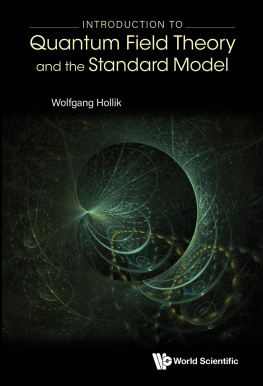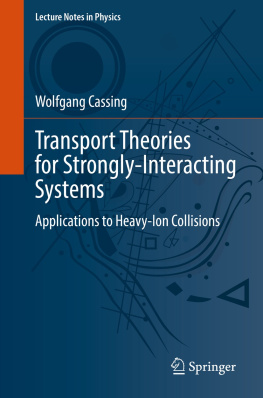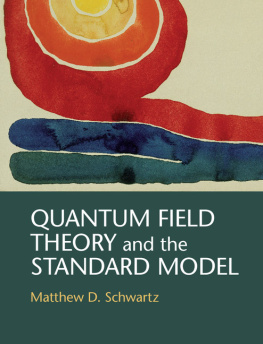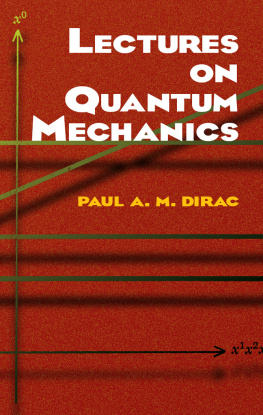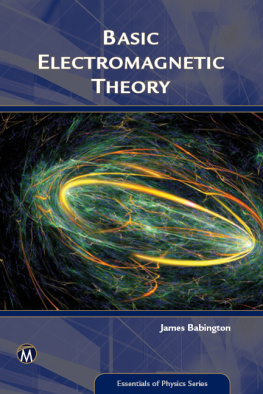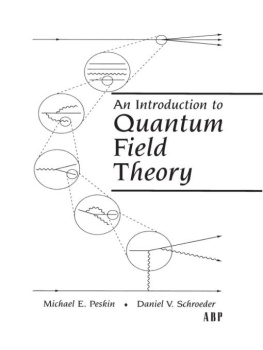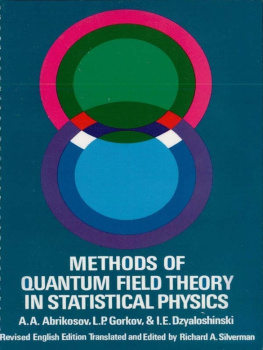Wolfgang Hollik - Introduction To Quantum Field Theory And The Standard Model
Here you can read online Wolfgang Hollik - Introduction To Quantum Field Theory And The Standard Model full text of the book (entire story) in english for free. Download pdf and epub, get meaning, cover and reviews about this ebook. year: 2022, publisher: World Scientific Publishing Company, genre: Children. Description of the work, (preface) as well as reviews are available. Best literature library LitArk.com created for fans of good reading and offers a wide selection of genres:
Romance novel
Science fiction
Adventure
Detective
Science
History
Home and family
Prose
Art
Politics
Computer
Non-fiction
Religion
Business
Children
Humor
Choose a favorite category and find really read worthwhile books. Enjoy immersion in the world of imagination, feel the emotions of the characters or learn something new for yourself, make an fascinating discovery.
- Book:Introduction To Quantum Field Theory And The Standard Model
- Author:
- Publisher:World Scientific Publishing Company
- Genre:
- Year:2022
- Rating:4 / 5
- Favourites:Add to favourites
- Your mark:
- 80
- 1
- 2
- 3
- 4
- 5
Introduction To Quantum Field Theory And The Standard Model: summary, description and annotation
We offer to read an annotation, description, summary or preface (depends on what the author of the book "Introduction To Quantum Field Theory And The Standard Model" wrote himself). If you haven't found the necessary information about the book — write in the comments, we will try to find it.
Introduction To Quantum Field Theory And The Standard Model — read online for free the complete book (whole text) full work
Below is the text of the book, divided by pages. System saving the place of the last page read, allows you to conveniently read the book "Introduction To Quantum Field Theory And The Standard Model" online for free, without having to search again every time where you left off. Put a bookmark, and you can go to the page where you finished reading at any time.
Font size:
Interval:
Bookmark:

_______INTRODUCTION TO_______
Quantum Field Theory
and the Standard Model
Recommended Titles in Related Topics
Lectures of Sidney Coleman on Quantum Field Theory Foreword by David Kaiser
edited by Bryan Gin-ge Chen, David Derbes, David Griffiths, Brian Hill, Richard Sohn and Yuan-Sen Ting
ISBN: 978-981-4632-53-9
ISBN: 978-981-4635-50-9 (pbk)
Lectures on Quantum Field Theory
Second Edition
by Ashok Das
ISBN: 978-981-122-086-9
ISBN: 978-981-122-216-0 (pbk)
Foundations of Quantum Field Theory
by Klaus D Rothe
ISBN: 978-981-122-192-7
ISBN: 978-981-122-300-6 (pbk)
Mathematical Foundations of Quantum Field Theory
by Albert Schwarz
ISBN: 978-981-3278-63-9
________INTRODUCTION TO_________
Quantum Field Theory
and the Standard Model
Wolfgang Hollik
Max Planck Institute for Physics, Germany

Published by
World Scientific Publishing Co. Pte. Ltd.
5 Toh Tuck Link, Singapore 596224
USA office: 27 Warren Street, Suite 401-402, Hackensack, NJ 07601
UK office: 57 Shelton Street, Covent Garden, London WC2H 9HE
Library of Congress Cataloging-in-Publication Data
Names: Hollik, W. (Wolfgang), 1951author.
Title: Introduction to quantum field theory and the standard model / Wolfgang Hollik, Max Planck Institute for Physics, Germany.
Description: New Jersey : World Scientific, [2022] | Includes bibliographical references and index.
Identifiers: LCCN 2021050559 (print) | LCCN 2021050560 (ebook) | ISBN 9789811242175 (hardcover) | ISBN 9789811242182 (ebook) | ISBN 9789811242199 (ebook other)
Subjects: LCSH: Quantum field theory.
Classification: LCC QC174.45 .H647 2022 (print) | LCC QC174.45 (ebook) | DDC 530.14/3--dc23/eng/20211201
LC record available at https://lccn.loc.gov/2021050559
LC ebook record available at https://lccn.loc.gov/2021050560
British Library Cataloguing-in-Publication Data
A catalogue record for this book is available from the British Library.
Copyright 2022 by World Scientific Publishing Co. Pte. Ltd.
All rights reserved. This book, or parts thereof, may not be reproduced in any form or by any means, electronic or mechanical, including photocopying, recording or any information storage and retrieval system now known or to be invented, without written permission from the publisher.
For photocopying of material in this volume, please pay a copying fee through the Copyright Clearance Center, Inc., 222 Rosewood Drive, Danvers, MA 01923, USA. In this case permission to photocopy is not required from the publisher.
For any available supplementary material, please visit https://www.worldscientific.com/worldscibooks/10.1142/12415#t=suppl
Typeset by Stallion Press
Email:
Printed in Singapore
Preface
These lecture notes are based on material presented during courses at the Technical University Munich (TUM) to physics students with interest in particle physics and its theoretical foundation. This material has been elaborated and expanded, to provide both the conceptual ideas regarding the Standard Model of particle physics and some technical details on the formulation within the context of gauge theories. The scope ranges from relativistic quantum mechanics to an introduction to quantum field theory with quantum electrodynamics as an example of a successful theory of a fundamental interaction, and is further extended towards quantum chromo-dynamics for the strong interaction and to the electroweak Standard Model for the unified electromagnetic and weak interactions, which could celebrate an enormous success by the 2012 discovery of a new spin-0 particle showing the properties of the predicted Higgs boson.
Quantum field theory is the primary theoretical tool for the description of the microscopic dynamics of the strong and electroweak interactions. It is thus necessary to provide an introduction to the basic concepts of relativistic quantum field theory, perturbation theory, Feynman graphs, before advancing to Abelian and non-Abelian gauge theories and their application to the fundamental forces and the resulting phenomenological implications with their experimental tests. The success of perturbative QCD at high energies goes with the basic features of asymptotic freedom and the parton model, displayed in the chapter on QCD. Phenomenology of W and Z bosons as well as Higgs bosons is part of the electroweak chapter including recent experimental results, precision tests and current status of the Standard Model.
The style is elementary and pedagogical. The text is at a level appropriate for students who had already a course in quantum mechanics and are familiar with classical electrodynamics and the basics of special relativity. Special relativity in the first chapter is a compact recapitulation serving as a summary and for setting the language and notations. The formalism of quantum field theory is kept at a minimum. Especially the Feynman rules are not derived in a systematic way; instead, the method is elucidated on the basis of examples to convey a more intuitive understanding that is thought to be more helpful for an early overview rather than proofs and advanced technical effort. Explicit calculations are performed for selected examples so that the reader becomes acquainted with practical calculations in particular for scattering amplidudes, cross sections and decay rates at lowest order. Extra material on specific theoretical issues is included in various places for the interested student; it can be skipped during a first reading.
The lecture notes provide a compact introduction, convenient for students dealing with particle physics and related areas to get first information before specializing towards experimental or theoretical topics. They may also serve as a basis to study elaborate textbooks, like Michael Peskin and Daniel Schroeders An Introduction to Quantum Field Theory (Westview Press, 1995), Matthew Schwartzs Quantum Field Theory and the Standard Model (Cambridge University Press, 2014), or Steven Weinbergs The Quantum Theory of Fields (Cambridge University Press, 1995).
It is my special concern to thank my colleagues from the Physics Department at TUM, Peter Fierlinger, Lothar Oberauer, Stephan Paul, and Stefan Schnert, for the pleasant cooperation during various lecture courses covering both experimental and theoretical aspects, over many years of teaching.
Wolfgang Hollik
Contents
Chapter 1
Special Relativity
It is a assumed that the reader is already familiar with special relativity, e.g. at the level of a first course on electrodynamics. Thus, this chapter serves essentially as a summary of the relevant theoretical ingredients, to introduce notations and conventions, and to provide the classical basis for advancing to quantum theory in the subseqent chapters.
The Special Theory of Relativity is based on the following two fundamental principles.
(1)Principle of relativity
The laws of nature are in all inertial frames of the same form.
(2)Invariance of light propagation
The propagation of light is independent of the inertial frame. For a pointlike source at a space point 
Font size:
Interval:
Bookmark:
Similar books «Introduction To Quantum Field Theory And The Standard Model»
Look at similar books to Introduction To Quantum Field Theory And The Standard Model. We have selected literature similar in name and meaning in the hope of providing readers with more options to find new, interesting, not yet read works.
Discussion, reviews of the book Introduction To Quantum Field Theory And The Standard Model and just readers' own opinions. Leave your comments, write what you think about the work, its meaning or the main characters. Specify what exactly you liked and what you didn't like, and why you think so.

